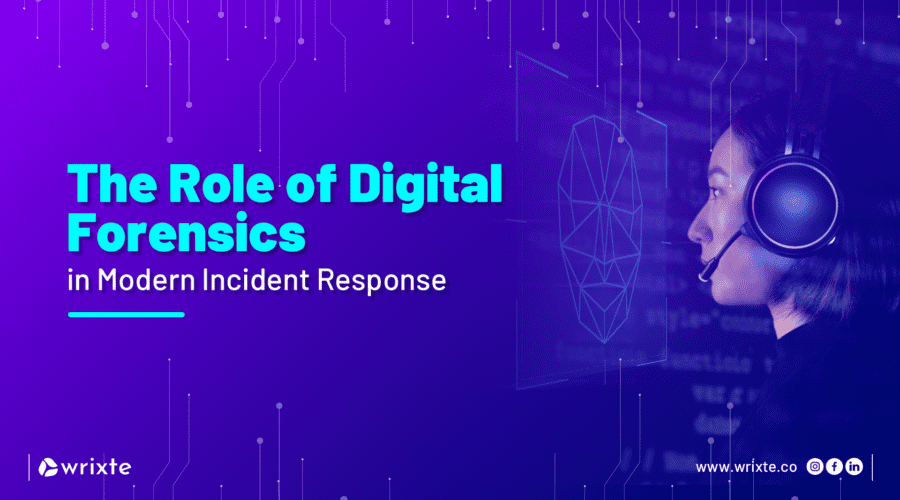In today’s cybersecurity landscape, the intersection of digital forensics and incident response has become critical for organizations facing increasingly sophisticated cyberattacks. The evolving threat landscape necessitates a robust framework where digital forensics plays a crucial role in investigating incidents, recovering evidence, and improving overall security posture. In this blog, we delve into the role of digital forensics in modern incident response, focusing on its key functions and the technical intricacies that make it indispensable.
What are Digital Forensics in Incident Response?
Digital forensics refers to the process of identifying, preserving, analyzing, and presenting digital evidence. Unlike traditional forensics, digital forensics primarily deals with electronic data stored in devices like computers, servers, or smartphones. Incident response, on the other hand, refers to the structured approach to handling cybersecurity incidents, minimizing damage, and recovering as swiftly as possible.
When an incident occurs—whether it’s a data breach, ransomware attack, or insider threat—the synergy between incident response and digital forensics ensures that the organization can not only mitigate the immediate threat but also learn from the incident to bolster future defenses.
Phases of Digital Forensics in Incident Response
- Identification and Triage
The first stage in any cybersecurity event involves identifying the nature and scope of the incident. Digital forensics begins here by helping detect and categorize compromised systems, identifying affected assets, and determining whether the breach involves internal or external actors. For instance, forensic analysis can identify malware signatures or trace unusual network traffic back to its source. This is especially important in cases where multiple systems are impacted, as it helps prioritize which systems require immediate attention. - Evidence Preservation
Once the incident is identified, the primary focus shifts to preserving evidence. One of the biggest mistakes organizations make during incident response is altering or corrupting evidence unintentionally. Digital forensics provides tools and methodologies to create forensic images (exact replicas) of compromised systems, ensuring that the original data remains unmodified. Tools such as FTK Imager or EnCase are commonly used to perform this task. Preserving evidence is crucial, as tampered evidence could hinder legal proceedings or further investigations. - Detailed Forensic Analysis
After the evidence is collected, forensic experts dive deep into the analysis phase. This step involves parsing through logs, file systems, and registry data to piece together the attack timeline and uncover how the breach occurred. During this phase, digital forensics professionals can often answer critical questions such as:- How did the attacker gain access to the system?
- Which vulnerabilities were exploited?
- Was any data exfiltrated, and if so, which files?
- In ransomware attacks, for example, digital forensics helps decrypt files and identify the variant of ransomware used, often providing clues to the attackers’ infrastructure or tools.
- Incident Containment and Eradication
Based on forensic analysis, the incident response team can then take well-informed actions to contain the incident and prevent it from spreading. Forensics can also pinpoint persistent threats that have been embedded in the network, such as rootkits or backdoors. The eradication phase uses the intelligence gathered from forensics to neutralize the attacker’s presence.
A noteworthy example is the SolarWinds cyberattack, where digital forensic efforts helped uncover sophisticated malware embedded in network management software, leading to a global incident response effort to contain the fallout. - Post-Incident Recovery and Reporting
After containment, digital forensics plays a role in the recovery phase by validating that all malicious traces have been eradicated and ensuring that systems can be safely restored to their previous state. The forensics team will also compile a detailed report of the incident, including an attack timeline, identified vulnerabilities, and the response actions taken. These reports are critical not just for internal audits but also for legal, compliance, or insurance purposes. Additionally, they serve as valuable lessons to prevent similar incidents in the future.
Forensics in Legal and Compliance Contexts
Digital forensics also holds substantial value beyond immediate incident response. In legal contexts, it can provide concrete evidence for prosecution, allowing organizations to pursue legal action against attackers or insiders. For compliance, especially in industries governed by strict regulations like GDPR or HIPAA, digital forensics helps demonstrate that an organization took appropriate measures to investigate and respond to incidents.
For instance, under the GDPR, organizations are required to notify regulators and affected parties in the event of a data breach. A forensic investigation ensures that accurate details about the nature and scope of the breach can be reported, potentially minimizing regulatory penalties.
Leveraging Forensics for Proactive Defense
Perhaps one of the most underappreciated roles of digital forensics is its application in proactive defense strategies. By analyzing past incidents, organizations can identify recurring attack vectors or vulnerabilities, enabling them to fine-tune their cybersecurity measures. Forensics is instrumental in threat intelligence sharing as well, where organizations disseminate details about new malware or techniques discovered during investigations.
The Importance of Integration with Incident Response
The most successful cybersecurity strategies leverage digital forensics as a core part of their incident response plan. It’s not just about reacting to an incident but also about ensuring that forensic capabilities are built into the organization’s infrastructure. This includes having the right forensic tools on hand, training IT staff in forensic practices, and developing incident playbooks that incorporate forensic methodologies.
Many organizations are also turning to managed services that provide both digital forensics and incident response (DFIR) as a unified service. This allows for a seamless response when an attack occurs, as the forensic team can immediately get to work without waiting for external contractors or scrambling to gather evidence.
Conclusion
Digital forensics plays an indispensable role in modern incident response, offering in-depth investigative capabilities that ensure incidents are not only mitigated but also thoroughly understood. From identifying the root cause to ensuring evidence integrity, forensics supports every phase of incident response, helping organizations improve their defenses and meet legal and regulatory requirements. By integrating digital forensics into incident response frameworks, organizations can better defend against increasingly complex cyber threats and enhance their overall resilience in the face of attacks.
